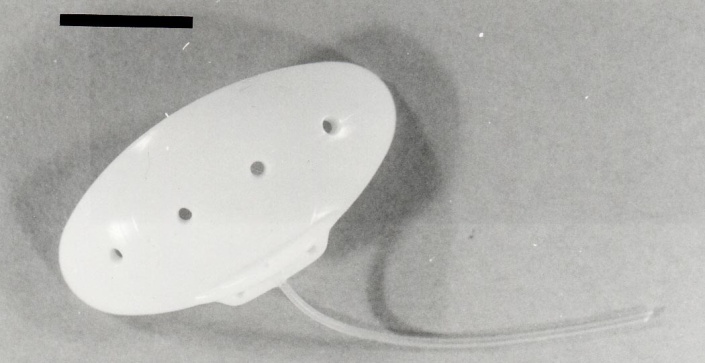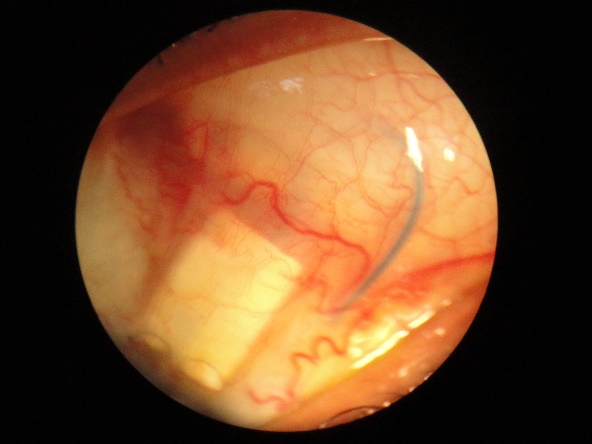What is tube surgery for?
Tube surgery is one of the treatments for glaucoma.
Glaucoma is the name of a group of conditions in which the optic nerve at the back of the eye is damaged. This can cause you to lose your peripheral vision (side vision), and eventually the central vision as well.
Damage usually occurs from increased pressure in the eye. In most cases, this can be controlled by drops. If the pressure does not come down with drops you will be offered surgery, such as tube surgery.
What is this ‘tube’?
The tube is also known as an aqueous shunt. There is a tube connected to a small device as shown in the pictures below.


The device is put into the eye during an operation that allows excess fluid to drain. It is put towards the back of your eye, and you will not be able to see it. A small blister or‘bleb’ forms, which is where the fluid will drain to, which in turn will reduce the pressure.


You can’t feel the bleb and tube, and you cannot feel the fluid flowing through them.
The picture on the right shows you what your eye will look like after the operation. The very tip of the tube is visible at about one o’clock.
To stop the tube from moving around and to ensure it is covered properly it needs to be covered with a patch of transplant tissue. This tissue is called ‘Tutoplast’ which is processed donor pericardium. The tissue goes through numerous chemical processes which has been proven to remove all pathogens and sterilise the tissue without damaging it.
To ensure that the eye does not lose too much fluid after the operation there is a thread lining (prolene) within the tube, and we also place a stitch around the tube. This stops the pressure from dropping too low.
What are the benefits of tube surgery?
By allowing excess fluid to drain the tube surgery can reduce the pressure in the eye and prevent your glaucoma from getting worse. . This will help to maintain the vision you have. It is successful in 70-80% of patients
It should be noted the surgery is used to save the vision you have. It will not improve your vision or restore any vision you have lost.
What are the risks of tube surgery?
- Blurred vision- After the operation your sight may be blurred. This can take several weeks to return to normal
- Loss of vision – Although rare there is a chance you may lose vision in the operated eye
- Damage to the front of the eye (cornea)- The tube may rub on the inside of the cornea, which is the clear part at the front of the eye. This can cause it to become cloudy, and make your vision worse. In extreme cases it may require a corneal transplant.
- Bleeding- There is a small chance of bleeding inside the eye immediately after surgery which may require further treatment
- Cataract- The lens may develop clouding some years after surgery. This may require operation
- Double vision- There is a small chance that double vision can occur after surgery
- Infection- There is a small chance of infection inside the eye after surgery. This may require further treatment, and may ultimately result in sight loss
- Irritation- Grittiness or discomfort in eyes may occur after surgery
- Eyelid Drooping- The eye lid may become droopy on side of the operation
- Change in eye position – Occasionally the tube can affect how the eye sits in the socket which may require further surgery
- Tube blockage- There is small chance that the tube will become blocked. This would require further surgery to unblock the tube
- Tube erosion- There is small chance that the tube can become exposed or erode (wear away) through the conjunctiva which may require further surgery
What do I need to do to prepare for the operation?
The operation is done as a daycase, you will not need to stay overnight.
If you are having a general anaesthetic you will be given special instructions at your pre-operative assessment before you come into hospital.
Take your regular glaucoma medication as normal, unless told otherwise.
What happens during the operation?
The operation is usually carried out under general anaesthetic – you will not be awake during the operation.
However, in some cases it can be done under local anaesthetic. You will not see what is happening; you will just see a bright light. You will be given anaesthetic to numb the eye, and if needed something can be given to help you feel relaxed.
During the operation, if you are awake, you will be asked to keep your head still, and lie as flat as possible. The operation normally takes 45 minutes to one hour.
What happens after the operation?
After the operation we put a small shield over your eye to protect it.
You will be given two sets of drops – a steroid to help control inflammation, and an antibiotic. You should avoid any strenuous activity like jogging and contact sports after the operation. In terms of work, most people take 2 weeks off work to recover.
We monitor you closely after your operation to ensure the pressures are controlled; you will be seen weekly for three weeks, and then a month later.
After 1-3 weeks if the pressure is too high we can use laser to break a stitch which goes around the tube. This will allow more fluid to flow out which can help bring the intraocular pressure down.
After 4 weeks of surgery if the pressure still remains high we can remove the thread lining in the tube. Again, this will allow more fluid to flow out which can help bring the intraocular pressure down. This is done in Theatre, and can be done under local anaesthetic.
If the intraocular pressure still continues to be high further medications may be required to control it.
Signs to look out for
After the surgery the eye will be red and swollen, and your vision will be blurry. The eyelid can also be a little sticky. Hot compresses can help with this.
There are symptoms that you need to look out for, as it could mean you need prompt treatment. These include:
- Excessive pain
- Sticky eye that continues to produce sticky discharge after gentle bathing with cooled boiled water
- Loss of vision
- Sudden worsening of vision
- Increasing redness of your eye
Should you get any of these you should ring ward 6 or attend urgent care out of hours.
Fairhurst Eye clinic
Telephone number - 01282 804201
Opening hours:
Monday to Friday 8am-8pm
Saturday 9am – 2pm
Sunday 9am – 2pm


